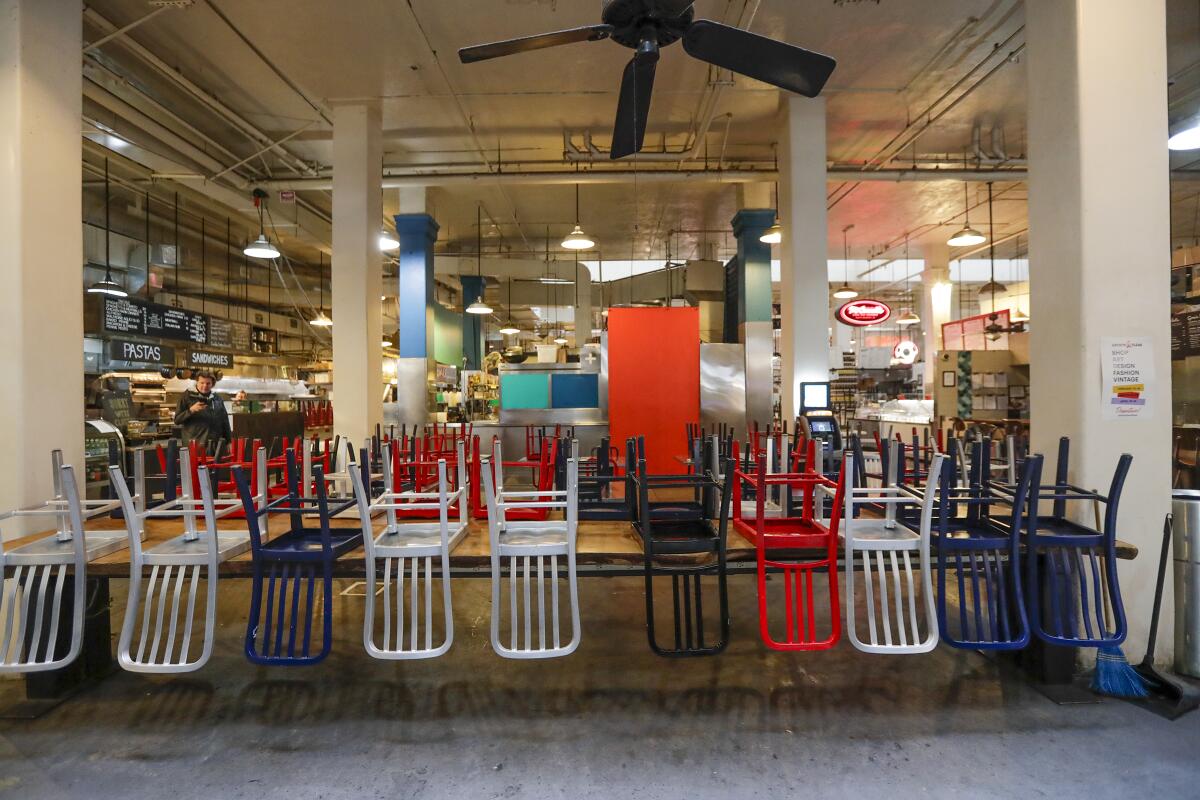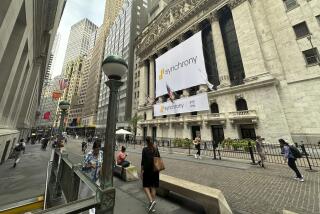News Analysis: Recession is coming. The only questions now are how soon and how deep

- Share via
WASHINGTON — When the world’s largest economy begins to shut down — closing schools, sports arenas and entire categories of businesses, and sending millions of American workers home — it’s no longer a question of whether a recession may be coming.
The only questions now are: How soon, how deep and how can the government best respond?
If the seriousness of the crisis was not clear before, the evidence was hard to miss on Sunday, when the Federal Reserve fired its biggest gun by dropping the nation’s key interest rate almost to zero. And then on Monday, President Trump issued even tougher guidelines to limit the spread of the coronavirus, advising Americans not to gather in groups of more than 10 and to avoid bars, restaurants and food courts.
But the result was another panic-driven plunge in stocks as the Dow fell nearly 13%, its steepest percentage drop in three decades. And even Trump, who had repeatedly put a bright face on the economy, acknowledged that the United States “may be” heading for recession.
Trump, at a daily press briefing Monday with his coronavirus task force at his side, said that it could be July or August before the health crisis passes.
What’s almost certain is that the nation’s nearly 11-year record run of economic growth is ending this spring. In the view of UCLA forecasters and others, the country already is in recession.
Airline bookings, restaurant traffic and activity at ports have plunged. On Monday, in one of the earliest broad-based indicators released since the outbreak shell-shocked the U.S., the New York Fed’s manufacturing survey for March saw its sharpest decline in two decades, with measures of employment, planned tech spending and new orders tanking.
“Data is pretty clear the U.S. economy is contracting at a fairly good clip,” said Jerry Nickelsburg, senior economist at UCLA Anderson Forecast.
The Fed has thrown just about everything it has to support lending and keep credit markets from freezing up, but it wasn’t nearly enough to assuage anxious investors. The central bank could lower rates, now between 0% and 0.25%, into negative territory, but policymakers don’t think that’ll do much good. The Fed could also consider buying equities and corporate bonds, but that would probably require congressional expansion of its authority.
The focus is now squarely on fiscal policy.
Trump’s chief economic advisor, Larry Kudlow, said Monday that White House proposals already announced to combat the coronavirus add up to roughly $400 billion worth of stimulus. That includes a three-month deferral of income taxes due April 15, national emergency funds to support public health efforts to states, and help for small businesses and relief for student loan borrowers. The administration also plans to spend $75 million to buy oil to add to the nation’s reserves. That will help some U.S. producers in the short term, but doesn’t erase the insolvency threat many will face because of falling crude prices.
Trump and Kudlow said they were considering financial assistance to airlines. Boeing, hammered by the coronavirus and internal problems with the 737 Max, was said to be among the companies talking with the White House about short-term aid.
Kudlow said the administration was continuing to seek congressional support for a Social Security payroll tax cut for the rest of the year, a plan that he said would cost about $400 billion. Lawmakers in both parties and many economists have panned the proposal, however, in large part because it doesn’t do anything for those who aren’t working.
Instead, a growing number of economists, conservative and liberal, have argued that the federal government should send a $1,000 check to everyone as soon as possible. That would be more effective “considering the difficulty of identifying the truly needy and the problems inherent in trying to do so,” said Greg Mankiw, a Harvard economist who served as an advisor to President George W. Bush and other Republican politicians.
Congress, meanwhile, continues to consider legislation passed by the House over the weekend that would make coronavirus testing free and provide paid sick leave to many of those affected.
How quickly lawmakers can act remains an open question. And how much good they will do is unclear given that the economic impact of an extraordinary medical emergency is hard to fight with traditional monetary and fiscal strategies.
Lowering interest rates, for example, makes the financing of big-ticket purchases cheaper. But when consumers are staying home to avoid a spreading disease, the price of the car or house or computer is irrelevant.
Lower interest rates also make it easier for companies to finance new plants and equipment. But if a pandemic is forcing consumers to practice social distancing, as federal health authorities now recommend for everyone, there’s little incentive to produce more goods.
At first when the coronavirus outbreak hit, analysts viewed the economic threat as mainly a supply problem: Companies couldn’t get products amid the closing of Chinese factories and disruptions to supply lines and transportation networks.
But as the New York Fed survey and other reports showed, the U.S. economy is now entering a perilous period of not just a breakdown in supplies, but a sudden and dramatic collapse in demand.
Restaurants in the U.S. had a terrific Valentine’s Day, and the number of diners on March 1 was up a notch from a year earlier, according to OpenTable, the reservations firm that tracks data from nearly 60,000 restaurants. But on each successive day since then, business has spiraled downward, with the customer count down 48% on Sunday.
The Wall Street firm Goldman Sachs said Monday that it now sees U.S. economic growth grinding to a halt in the current quarter and shrinking a whopping 5% in the second quarter. If that happens, it will be the second-largest quarterly drop in nearly four decades.
Goldman said the economy could rebound strongly in the second half of the year, but other analysts say it could be a slow recovery. Economists at IHS Markit also Monday revised sharply downward their outlook, saying they expect a recession to begin in the second quarter and “legacy effects” from the consumer pullback to result in negative growth through the end of the year.
“Even as consumer spending begins to recover during the summer, the legacy effects of the second-quarter contraction of [consumer spending], continuing declines in energy exploration and production, and weak overseas growth will result in negative growth,” said Joel Prakken, IHS Markit’s chief U.S. economist.
His projection for the second half of the year: an average decline of nearly 2% in U.S. gross domestic product.
More to Read
Inside the business of entertainment
The Wide Shot brings you news, analysis and insights on everything from streaming wars to production — and what it all means for the future.
You may occasionally receive promotional content from the Los Angeles Times.










